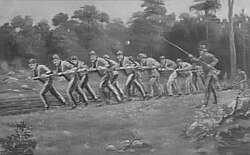Draft:Penal labour in Australia
 | Draft article not currently submitted for review.
This is a draft Articles for creation (AfC) submission. It is not currently pending review. While there are no deadlines, abandoned drafts may be deleted after six months. To edit the draft click on the "Edit" tab at the top of the window. To be accepted, a draft should:
It is strongly discouraged to write about yourself, your business or employer. If you do so, you must declare it. Where to get help
How to improve a draft
You can also browse Wikipedia:Featured articles and Wikipedia:Good articles to find examples of Wikipedia's best writing on topics similar to your proposed article. Improving your odds of a speedy review To improve your odds of a faster review, tag your draft with relevant WikiProject tags using the button below. This will let reviewers know a new draft has been submitted in their area of interest. For instance, if you wrote about a female astronomer, you would want to add the Biography, Astronomy, and Women scientists tags. Editor resources
Last edited by Landpin (talk | contribs) 15 days ago. (Update) |
| Part of a series on |
| Forced labour and slavery |
|---|
 |
Penal labour in Australia exists as part of a framework of rehabilitation.
Across all jurisdictions of the United Kingdom, imprisonment with "hard labour" ended through legislation passed in the late 1940s and 1950s, but in general penal labour remains.
History
[edit]

The British penal colonies in Australia between 1788 and 1868 provide a major historical example of convict labour, as described above: during that period, Australia received thousands of transported convict labourers, many of whom had received harsh sentences for minor misdemeanours in Britain or Ireland.
As late as 1885, 75% of all prison inmates were involved in some sort of productive endeavour, mostly in private contract and leasing systems. By 1935, the portion of prisoners working had fallen to 44%, and almost 90% of those worked in state-run programmes rather than for private contractors.[1]
The crank machine was a device which turned a crank by hand which in turn forced four large cups or ladles through sand inside a drum, doing nothing useful. Male prisoners had to turn the handle 6,000–14,400 times over the period of six hours a day (1.5–3.6 seconds per turn), as registered on a dial. The warder could make the task harder by tightening an adjusting screw.[2]
Modern prison labour systems
[edit]Western Australia
[edit]In Western Australia, as of 2022, weekly gratuities range from $24.72 to $78.76.[3]
Victoria
[edit]In Victoria, as of 2024, Victorian prisoners earn between $3.95 to $8.95 a day.[4]
South Australia
[edit]In South Australia, prisoners are paid a small allowance for each day they do work.[5]
New South Wales
[edit]In New South Wales, as of 2023, inmates' weekly wages range from $25.07 to $71.37, based on a five-day, 30-hour week.[6]
Tasmania
[edit]In 2024, prisoners' wages ranged from $15 to $67.50, and this range was increased to a minimum of $16.50 and a maximum of $67.50.[7]
Queensland
[edit]Australian Capital Territory
[edit]As of 2024, in the Alexander Maconochie Centre, Canberra's only prison, inmates' pay ranges from $25 to $70.[9]
Northern Territory
[edit]As of 2020, prisoners in the Northern Territory earn at least $32, per week.[10]
References
[edit]- ^ Reynolds, Morgan O. (1994). "Using the Private Sector to Deter Crime". Journal of Social, Political and Economic Studies. 19 (2). National Center for Policy Analysis: 33.
- ^ "Inveraray Jail and County Court, Life in Jail". Archived from the original on 12 February 2015.
- ^ Zimmerman, Josh (30 July 2022). "Criminals in WA prisons given pay rise higher than guards". The West Australian. Archived from the original on 6 March 2024. Retrieved 4 April 2025.
- ^ Staszewska, Ewa (27 May 2024). "The 'damaging' $7 charge prisoners face — and the push to have it dumped". SBS News. Archived from the original on 11 June 2024. Retrieved 4 April 2025.
- ^ Services, Department for Correctional (22 September 2020). "Prisoner employment". www.corrections.sa.gov.au. Retrieved 4 April 2025.
- ^ Ransley, Ellen (10 March 2023). "Think tank proposes prisoners work full time to fill job vacancies, save economy $2bn". news.com.au. Archived from the original on 11 March 2023. Retrieved 4 April 2025.
- ^ "On 'Improvements to Prison Service…". Tasmanian Times. Archived from the original on 23 December 2024. Retrieved 4 April 2025.
- ^ 2011 Report on Queensland Prisons (PDF) (Report). 2011. Archived (PDF) from the original on 8 December 2024. Retrieved 4 April 2025.
- ^ McKnight, Albert (1 June 2024). "What's it like to get locked up at Canberra's jail? Detainee handbook outlines life in prison". Region Canberra. Region Media. Archived from the original on 4 April 2025. Retrieved 4 April 2025.
- ^ Gibson, Jano (30 May 2020). "NT prisoners can earn money in jail, but they're not always paid their due". ABC News. Archived from the original on 25 July 2020. Retrieved 4 April 2025.
